Multiple variations of the HELL-BENT HEMI: DODGE CHARGER SRT HELLCAT WIDEBODY has been around for 16 years.But the almost-ultimate Dodge Charger may be this one – a Hellcat Widebody that chews up the asphalt while carrying four adults in comfort, blogs Dan Scanlan.
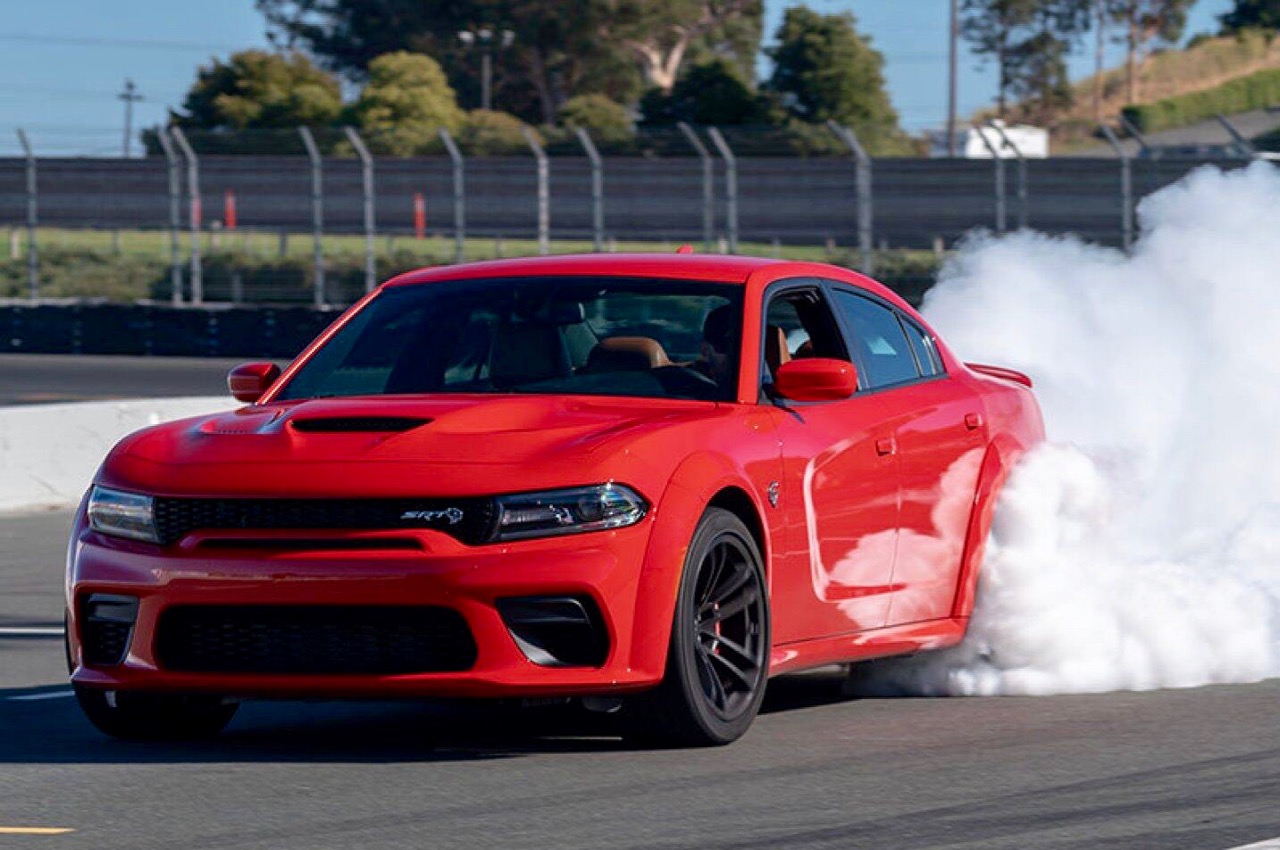 Dodge took the standard 75-inch-wide Charger Hellcat with its 707-horsepower HEMI V-8, and added 3.5-inches so there’s room for 20-inch by 11-inch wheels wearing fatter P305/35 ZR20-inch Pirelli P-ZERO tires. That supercharged 6.2-liter HEMI Hellcat V-8 and its 650 pound-feet of torque lives under our tester’s optional lightweight satin black aluminum hood and breathes through a wide center scoop with sunken side vents. Oh yeah – our tester came in a subtle Octane Red.
Dodge took the standard 75-inch-wide Charger Hellcat with its 707-horsepower HEMI V-8, and added 3.5-inches so there’s room for 20-inch by 11-inch wheels wearing fatter P305/35 ZR20-inch Pirelli P-ZERO tires. That supercharged 6.2-liter HEMI Hellcat V-8 and its 650 pound-feet of torque lives under our tester’s optional lightweight satin black aluminum hood and breathes through a wide center scoop with sunken side vents. Oh yeah – our tester came in a subtle Octane Red.
Dodge says its latest muscle car – HELL-BENT HEMI: DODGE CHARGER SRT HELLCAT WIDEBODY is “The “most powerful and fastest mass-produced sedan in the world, can hit 60 mph in just 3.6 seconds and top out at 196 mph.” And when I remote-started it off the key fob, our poor dog jumped at our 12,000-mile-old test car’s exhaust bark and rumble at idle!
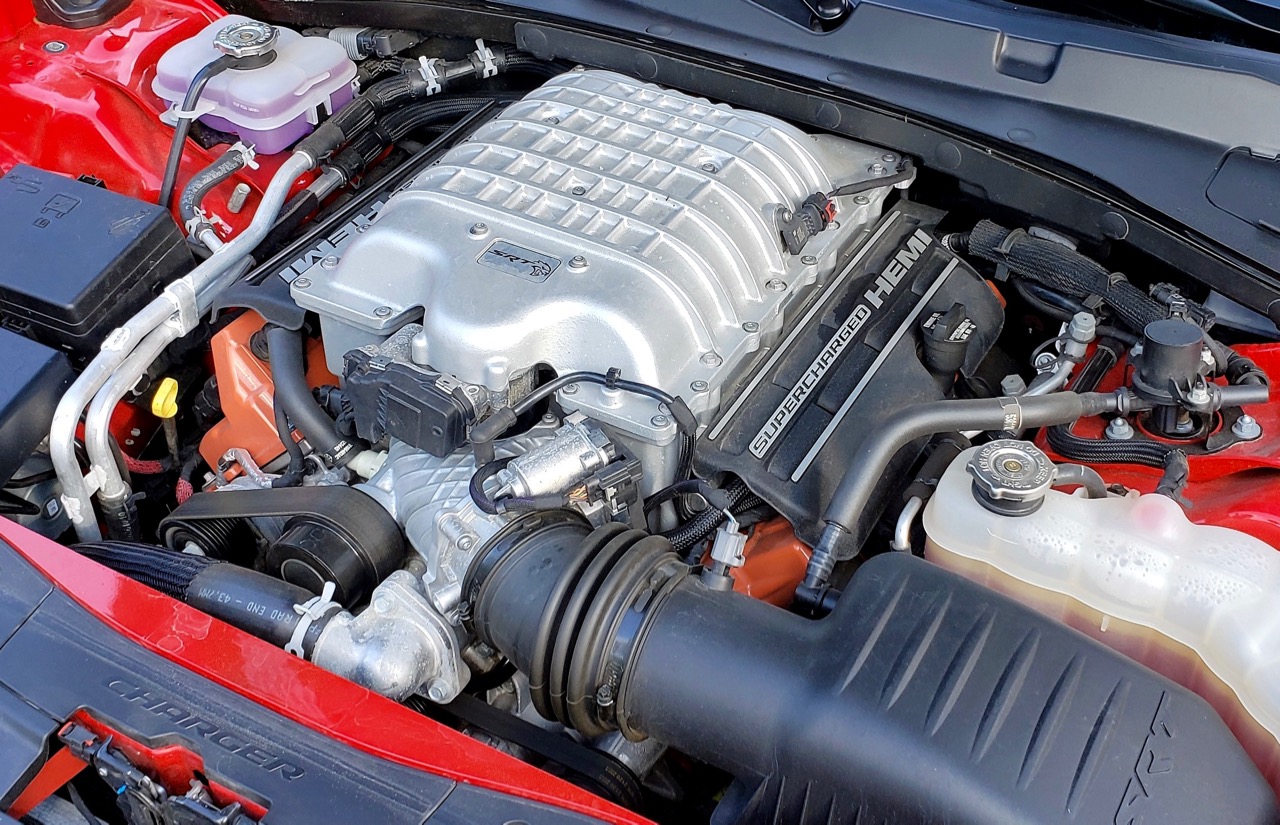 Yes, there’s heritage under that hood with HEMI Orange rocker covers topped by a massive ribbed alloy supercharger, hooked to a TorqueFlite eight-speed automatic transmission. If you want more, the Daytona Edition has 717-horsepower. Like most SRT Dodges, there are multiple modes in its Performance Pages. Eco mode does the usual for better fuel mileage, while the Auto setting gives all 707 horsepower, but with Street mode steering, suspension and traction control. Custom let me vary the power at 500 or 707, then set the rest to Street, Sport or Track depending how I wanted steering, shifting, suspension or traction to act.
Yes, there’s heritage under that hood with HEMI Orange rocker covers topped by a massive ribbed alloy supercharger, hooked to a TorqueFlite eight-speed automatic transmission. If you want more, the Daytona Edition has 717-horsepower. Like most SRT Dodges, there are multiple modes in its Performance Pages. Eco mode does the usual for better fuel mileage, while the Auto setting gives all 707 horsepower, but with Street mode steering, suspension and traction control. Custom let me vary the power at 500 or 707, then set the rest to Street, Sport or Track depending how I wanted steering, shifting, suspension or traction to act.
Sport alone gives all the power plus firmer shocks, full snarl from the dual exhausts and dialed-back traction control, so it easily spun rear rubber even on what we thought was a gentle launch. Launching hard in that mode also saw lots of wheelspin as the 2.4-liter supercharger wailed and dual exhaust bellowed. So I headed to Custom and put traction control on Street, with the rest on Track. Done thusly, we hit 60 mph in 4 seconds, and 100 mph in 8.9 seconds with traction control handling wheelspin as needed. The 8-speed automatic snapped off quick, almost brutal upshifts, accompanied by razor-sharp downshifts with throttle blips. We still spun the rears on and off through third gear as traction control kept us more or less straight. We nailed a .72G pull on launch!
 If you want to drag race, there’s a line-lock to set front brakes, but not the rears. Watch the video as we warmed up the Pirellis in back for a stickier launch. Launch control let me set optimum rpm rate to launch. I held the brakes as our gauge display told me to release. Then we saw 60 mph in 4.3 seconds, 100 in 9.3, and wheelspin. Using Eco for some highway stretches, we had a high of 16 mpg, and a low of 11 mpg when we played in Sport or Track. In comparison, our first Hellcat in 2016 with skinnier rubber saw 60 mph in 4.3 seconds.
If you want to drag race, there’s a line-lock to set front brakes, but not the rears. Watch the video as we warmed up the Pirellis in back for a stickier launch. Launch control let me set optimum rpm rate to launch. I held the brakes as our gauge display told me to release. Then we saw 60 mph in 4.3 seconds, 100 in 9.3, and wheelspin. Using Eco for some highway stretches, we had a high of 16 mpg, and a low of 11 mpg when we played in Sport or Track. In comparison, our first Hellcat in 2016 with skinnier rubber saw 60 mph in 4.3 seconds.
The Hellcat rides on wider (11- vs. 9.5-inch) Pirellis for more contact patch when you play, on top of adaptive ADS Bilstein shock absorbers, independent short/long arm front suspension and 5-link independent rear with stabilizer bars. Set in Eco or Custom and its comfy suspension setting, and the ride was taut but supple with quickly damped bumps. It was a nice daily mix of firm and comfort, firmer than the non-Widebody I tested a few year’s back. There’s hard-edged rebound over potholes in Sport and Track modes so you feel every bump. But the ride was almost livable, damped quickly with buffering. And the wider rubber helped the 4,587-pound sedan’s slightly nose-heavy 56/44 percent front/rear weight distribution, more eager to tackle a turn.
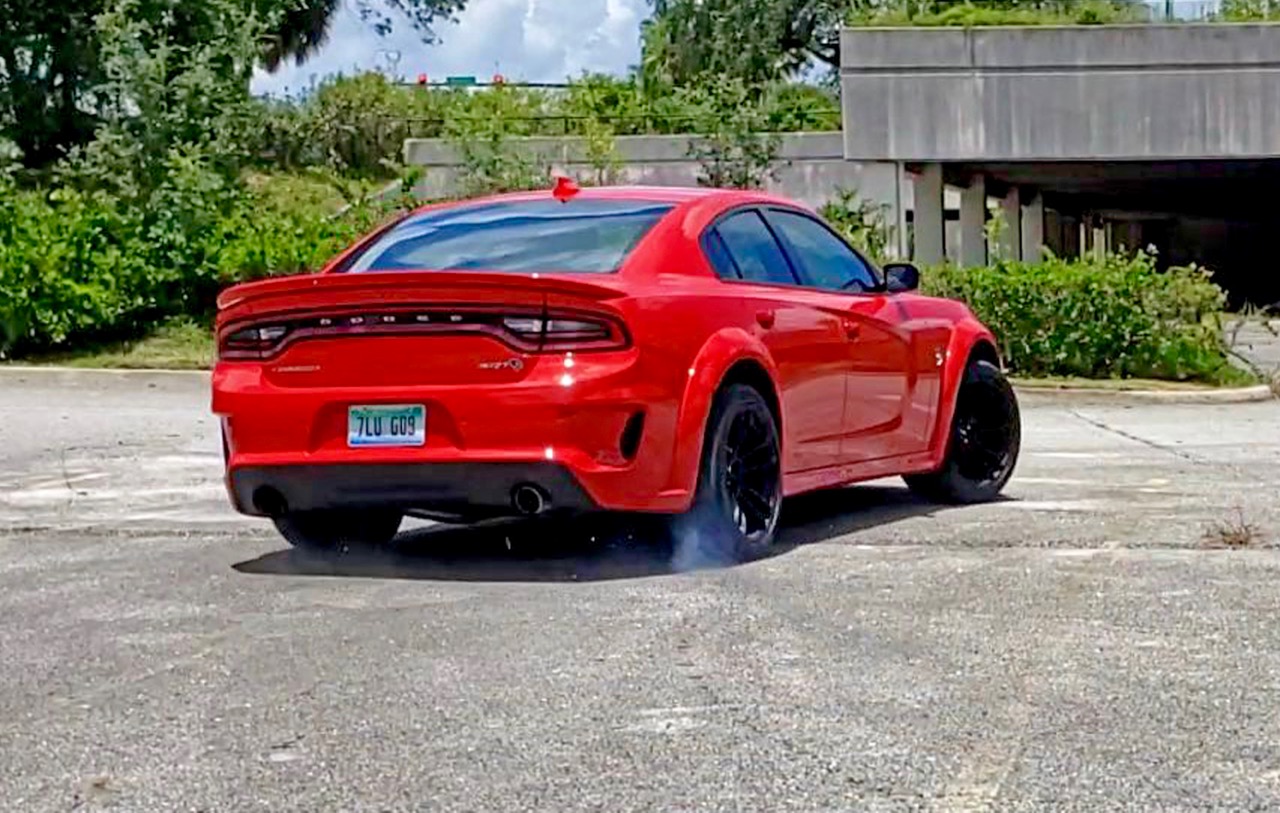 This wider version takes a set with a bit of body roll and just sails through corners and exit ramps neutrally under throttle, easy to love as it felt flatter and a bit happier around curves. The car stayed planted and secure, steering direct and talkative. Tap in Sport mode and the rear can power out on corners if you get enthusiastic. Play harder and you can catch it before the nannies kick in, powering the tail out, then catching via throttle and steering. If I kept traction control active in Custom mode, we pulled as high as 1.16Gs in a left-hander, and 1.06Gs in a right-hander as shown on the gauge display.
This wider version takes a set with a bit of body roll and just sails through corners and exit ramps neutrally under throttle, easy to love as it felt flatter and a bit happier around curves. The car stayed planted and secure, steering direct and talkative. Tap in Sport mode and the rear can power out on corners if you get enthusiastic. Play harder and you can catch it before the nannies kick in, powering the tail out, then catching via throttle and steering. If I kept traction control active in Custom mode, we pulled as high as 1.16Gs in a left-hander, and 1.06Gs in a right-hander as shown on the gauge display.
The new electric-assist steering is direct and pretty well weighted in Eco and Street modes, then really firms up in Sport and Track. There are Brembo six-piston front calipers with two-piece front brake rotors clamping 15.4-inch discs, and 13.8-inch rear discs grabbed by four-pistons Brembos in back. The perforated alloy-clad pedal had a nice bite high up, then progressive feel all the way to a solid stop with minimal nosedive and indicated 1.15Gs on the gauge display. We felt no brake fade after some very serious use at speed. Outside, this is one tough-looking muscle car. The flared fenders barely contain wide Pirellis tightly framed within them.
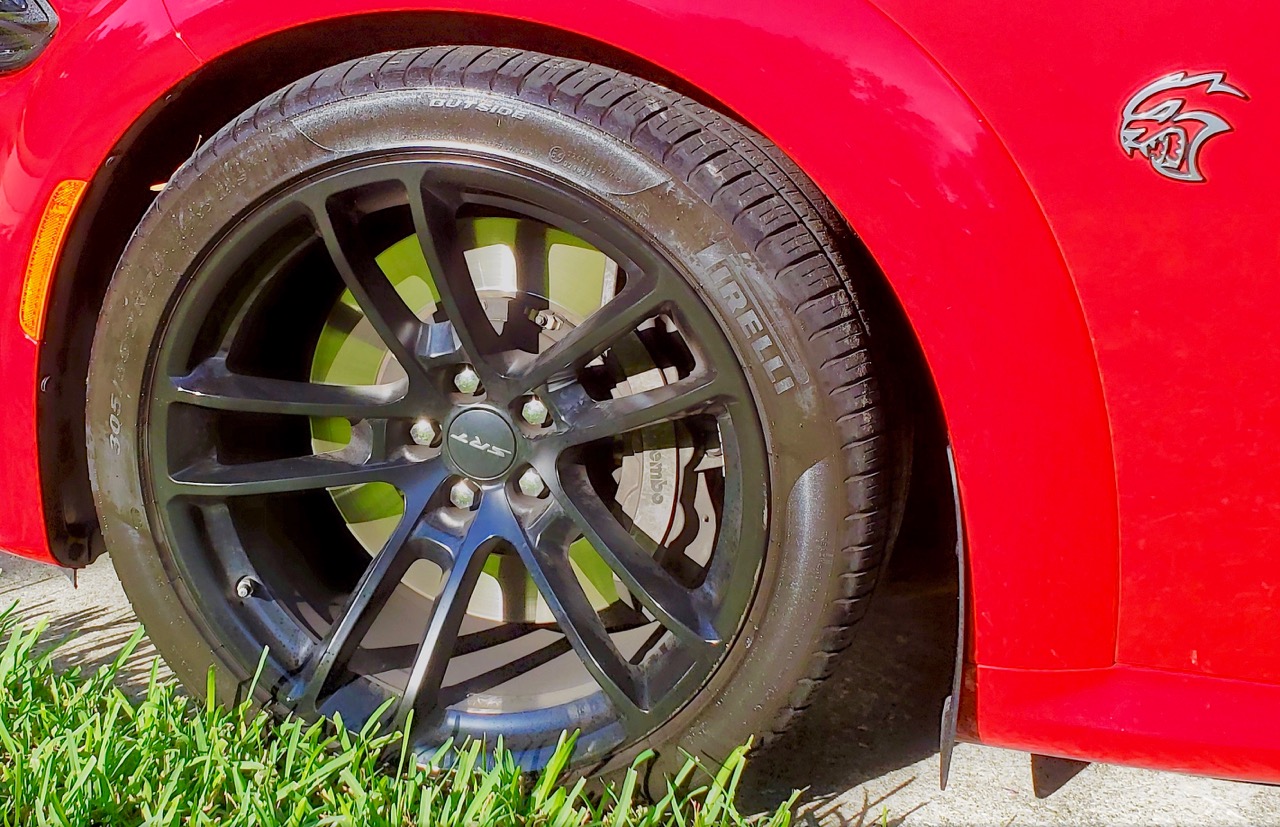 There’s a slimmer honeycombed strip between LED headlights with U-shaped running lights. There’s a slit intake atop the bumper centerline, then a gaping lower one with air dam and real brake inlets. The air dam flows into wider fender flares that wrap tightly around wider rubber on anodized black split-five spoke forged-aluminum wheels, huge disc brakes with Brembo calipers. The wider flares joined flared lower door sills as snarling Hellcat badges decorate grille, front fenders and trunk. The tall flanks get a nostalgic vent design incised in front doors to remind you of that ’69 Charger. The roof slopes sharply down past mid-point to join a trunk lid with substantial wing. Twin stainless steel exhaust pipes anchor a black fascia under a bumper incised with real vents.
There’s a slimmer honeycombed strip between LED headlights with U-shaped running lights. There’s a slit intake atop the bumper centerline, then a gaping lower one with air dam and real brake inlets. The air dam flows into wider fender flares that wrap tightly around wider rubber on anodized black split-five spoke forged-aluminum wheels, huge disc brakes with Brembo calipers. The wider flares joined flared lower door sills as snarling Hellcat badges decorate grille, front fenders and trunk. The tall flanks get a nostalgic vent design incised in front doors to remind you of that ’69 Charger. The roof slopes sharply down past mid-point to join a trunk lid with substantial wing. Twin stainless steel exhaust pipes anchor a black fascia under a bumper incised with real vents.
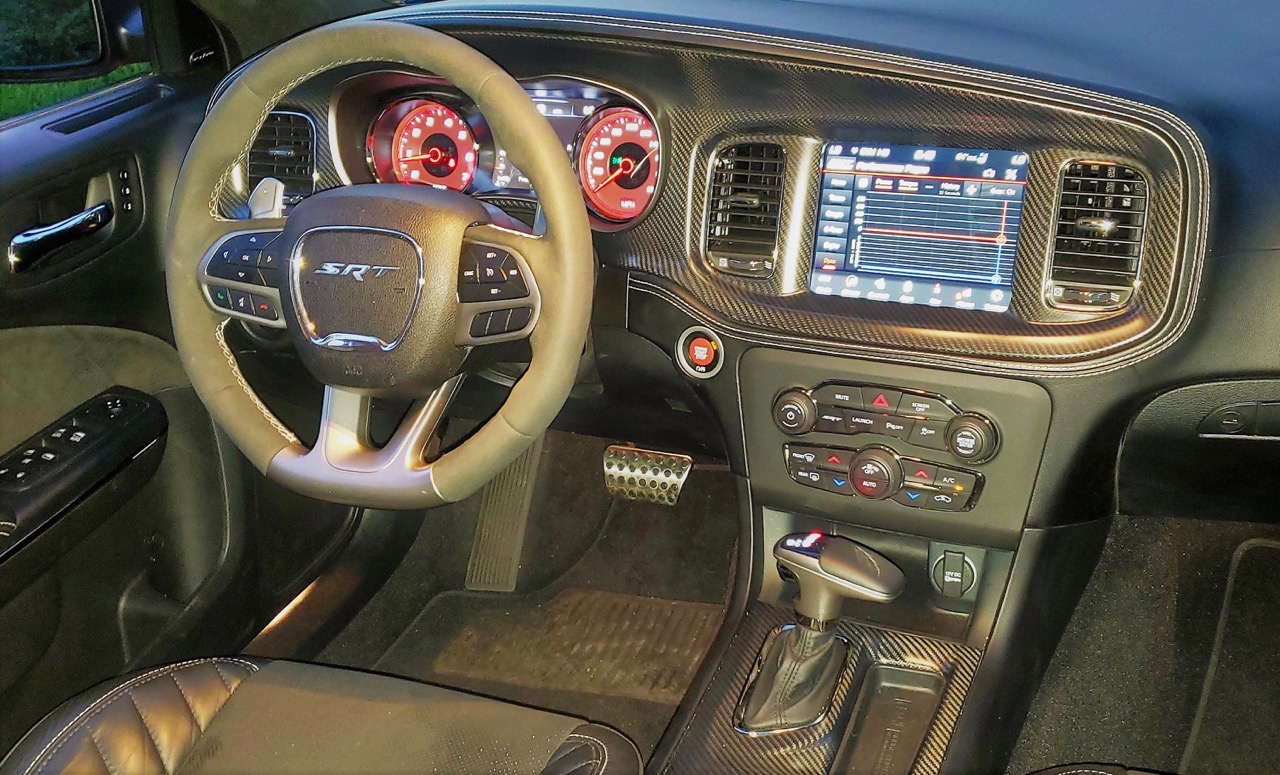 As for the familiar all-black interior that looks the same as every Charger made in the past nine years, it works just fine. The suede bucket seats with leather bolsters and contrasting stitching had 8-way power adjustments and twin memory presets for the driver. Heated and ventilated up front, they could use a bit more side bolstering and felt a bit wide and flat. Semi-gloss carbon fiber frames the red-faced 200-mph speedometer and 7,000-rpm (5,600-rpm redline) tach with center 7-inch color screen. It’s configurable. There’s a digital speedometer, fuel economy, engine power and torque, tire pressure, boost, supercharger/intercooler/engine gauges, plus voltage and G-force. Other settings show 0-to-60 mph and 0-to-100 mph timer, plus quarter-mile, lap and top speed. Alloy paddle shifters are behind the spokes with audio controls.
As for the familiar all-black interior that looks the same as every Charger made in the past nine years, it works just fine. The suede bucket seats with leather bolsters and contrasting stitching had 8-way power adjustments and twin memory presets for the driver. Heated and ventilated up front, they could use a bit more side bolstering and felt a bit wide and flat. Semi-gloss carbon fiber frames the red-faced 200-mph speedometer and 7,000-rpm (5,600-rpm redline) tach with center 7-inch color screen. It’s configurable. There’s a digital speedometer, fuel economy, engine power and torque, tire pressure, boost, supercharger/intercooler/engine gauges, plus voltage and G-force. Other settings show 0-to-60 mph and 0-to-100 mph timer, plus quarter-mile, lap and top speed. Alloy paddle shifters are behind the spokes with audio controls.
 More carbon fiber surrounds the 8.4-inch Uconnect touchscreen with navigation, smartphone, backup camera, Sirius Travel Link and a lot of apps that can be rearranged. Its Performance Pages display acceleration, braking, G-force, speed and braking, live dynamometer with power, torque and gearshifts, plus engine gauges and steering angle. It allows the driver to activate drive modes for custom tuning of suspension, engine, steering and transmission response, even a 1-button launch control.
More carbon fiber surrounds the 8.4-inch Uconnect touchscreen with navigation, smartphone, backup camera, Sirius Travel Link and a lot of apps that can be rearranged. Its Performance Pages display acceleration, braking, G-force, speed and braking, live dynamometer with power, torque and gearshifts, plus engine gauges and steering angle. It allows the driver to activate drive modes for custom tuning of suspension, engine, steering and transmission response, even a 1-button launch control.
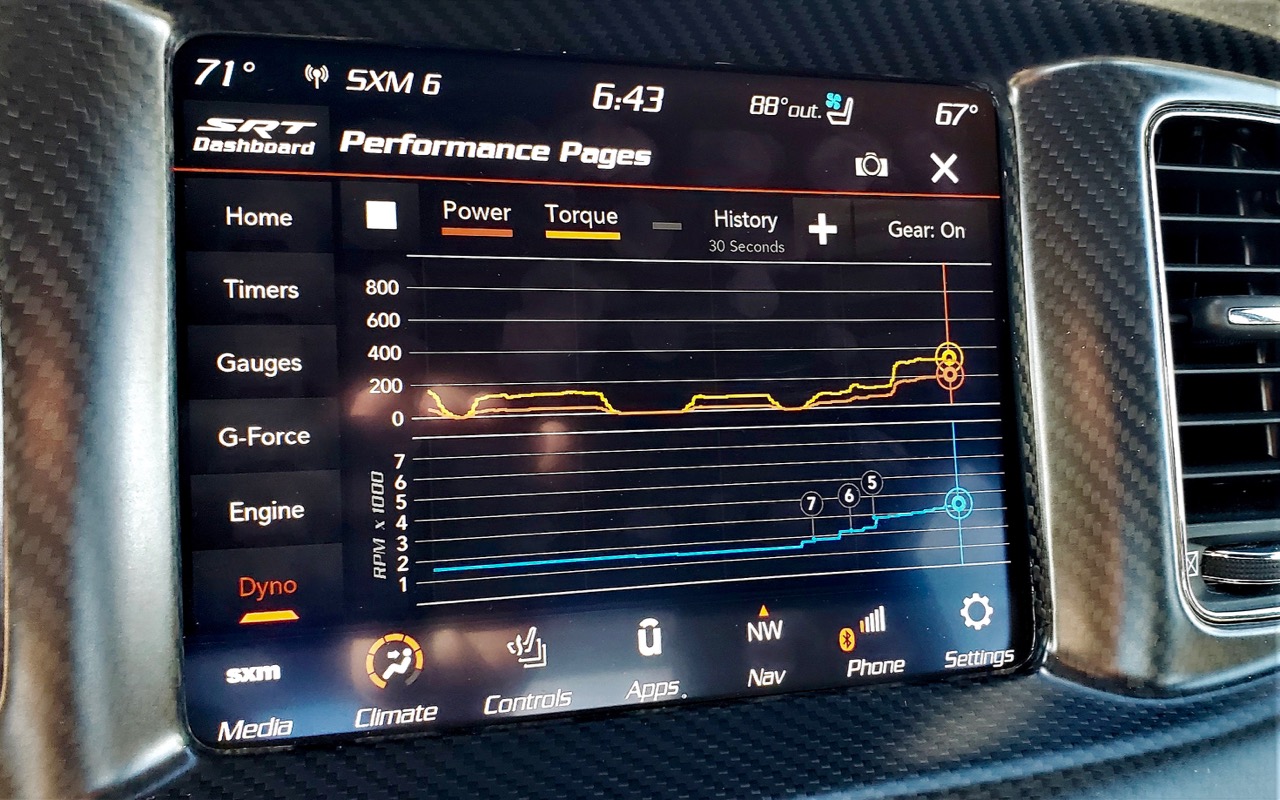 The powerful 19-speaker Harmon-Kardon audio system sounded good, but not great. The back seat has lots of head and leg room, although tall folks had to duck a bit to get under the semi-fastback roofline. There’s a 16.5-cubic-foot trunk, air pump, battery and storage space under its floor. It’s THE muscle car when you have a family, some plastic buttons and trim a bit simple to the touch, but still roomy, comfy and pretty well built.
The powerful 19-speaker Harmon-Kardon audio system sounded good, but not great. The back seat has lots of head and leg room, although tall folks had to duck a bit to get under the semi-fastback roofline. There’s a 16.5-cubic-foot trunk, air pump, battery and storage space under its floor. It’s THE muscle car when you have a family, some plastic buttons and trim a bit simple to the touch, but still roomy, comfy and pretty well built.
A base V-6/292-horsepower Dodge Charger starts at $29,995; and our HELL BENT HEMI: DODGE CHARGER SRT HELLCAT WIDEBODY starts at $69,645 with 707-horsepower, widebody flares and performance standard. Our options added looks and passenger comfort: $1,995 black hood; $1,995 sunroof; $1,795 Harmon-Kardon audio; $1,595 carbon fiber/suede headliner and interior with power front seats and steering wheel; $995 Alcantara suede seat and steering wheel accents and some smaller options for a total $83,205.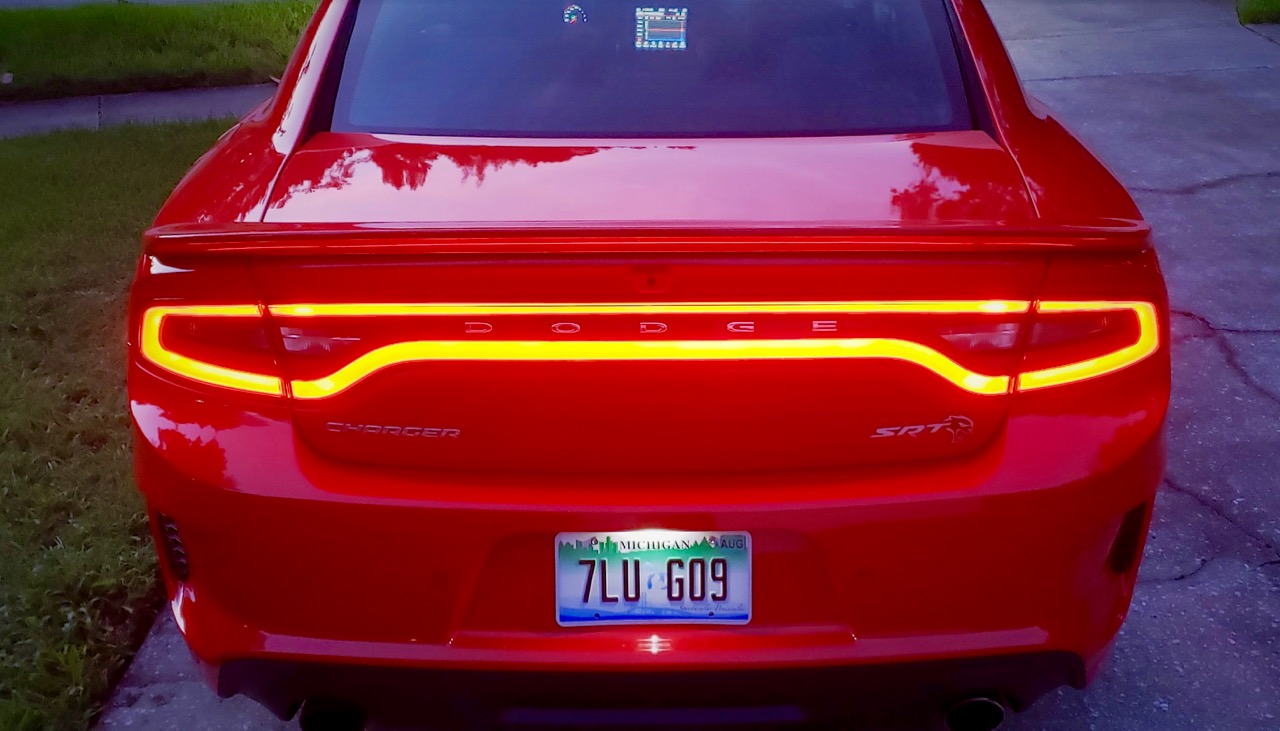 To sum it up, there may be some gray in the Charger’s mane, but this tougher and more menacing version shows there’s still nothing else like it that runs and handles like it, still holds four, for under $100,000.
To sum it up, there may be some gray in the Charger’s mane, but this tougher and more menacing version shows there’s still nothing else like it that runs and handles like it, still holds four, for under $100,000.
Watch and listen to HELL-BENT HEMI: DODGE CHARGER SRT HELLCAT WIDEBODY test @ https://www.youtube.com/watch?v=efb8Kq4k7wY&feature=youtu.be
For more information about the latest Chargers from Dodge, please visit https://www.dodge.com/charger.html
